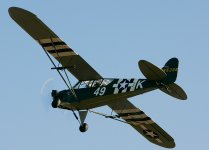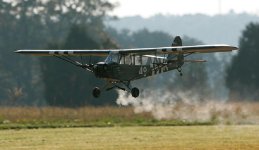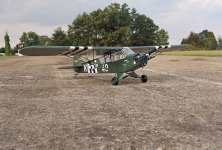LoboGunLeather
US Veteran
Tripped across this article this morning:
WWII heroics of 'Bazooka Charlie' doubted until Granville daughter sets record straight
Major Charles Carpenter, a WW2 reconnaissance pilot flying a Piper L4 Grasshopper, the military version of the venerable Piper Cub light single-engine airplane, about 800 lbs. of welded steel and wood frame covered with fabric.
Major Carpenter managed to mount 6 bazookas under the wings of the airplane and repeatedly attacked German tanks in low altitude and low speed attacks in support of US ground forces in the European Theater.
The airplane, named "Rosie the Rocketer" by Carpenter (himself nicknamed "Bazooka Charlie") has been found and restored. Reportedly located in Austria where its post-war usage was towing gliders. During restoration work numerous bullet holes were found, and signed names of the assembly workers were seen on the framework.
Now the subject of a book written by Major Carpenter's daughter.
WWII heroics of 'Bazooka Charlie' doubted until Granville daughter sets record straight
Major Charles Carpenter, a WW2 reconnaissance pilot flying a Piper L4 Grasshopper, the military version of the venerable Piper Cub light single-engine airplane, about 800 lbs. of welded steel and wood frame covered with fabric.
Major Carpenter managed to mount 6 bazookas under the wings of the airplane and repeatedly attacked German tanks in low altitude and low speed attacks in support of US ground forces in the European Theater.
The airplane, named "Rosie the Rocketer" by Carpenter (himself nicknamed "Bazooka Charlie") has been found and restored. Reportedly located in Austria where its post-war usage was towing gliders. During restoration work numerous bullet holes were found, and signed names of the assembly workers were seen on the framework.
Now the subject of a book written by Major Carpenter's daughter.
Last edited:




